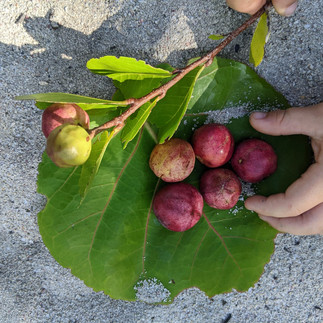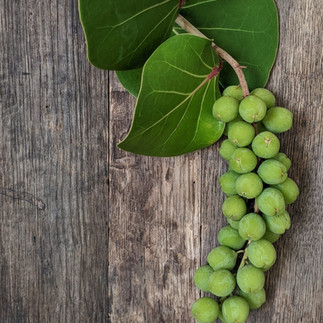
Creating colour from abundant natural resources
Barbados may be a small island, but it is one that boasts bountiful stores of unusual fruits, berries, nuts and seeds, all with their own intriguing properties, and I am not talking necessarily about the well known varieties, but the Dunks, Fat Porks, Sea Grapes, Dog Dumplings (aka Duppy Soursop, aka Noni Fruit) and Clammy Cherry to name a few.
I married a Bajan and one that grew up foraging in the countryside, one with a slightly disturbing knack for not only remembering all the names of all trees and fruits, but remembering exactly where they grow on the island. I have him to thank for inspiring and encouraging my recent escapades.
The story begins with Sea Island cotton Gossypium barbadense. The rarest, finest and most sought-after cotton in the world, grown and hand-picked here in Barbados since the 17th Century.

Sea Island Cotton
The cotton is luxurious, I would liken it more to silk in its texture and quality. Smooth to the touch and wonderful to work with, it plaits beautifully and, I discovered relatively recently, takes natural dye very well. I feel extremely lucky to be able to use this cotton in my work. The nature of my design means I only need small quantities and I hand make pieces to order so I use it in a very considered way with zero waste.
Naturally I wanted to explore colour with this medium. Barbados is awash with vivid hues from the brightly painted chattel houses and rum shops to the ladies in their Sunday best, the golden palms and the explosions of bougainvillaea on every corner, all amplified of course by the dazzling sun and backdrop of sparkling azure sea. But, I wanted to do the cotton justice, and so I started experimenting with natural dyeing techniques using the fruits, berries and leaves discovered on my expeditions.
The results were often surprising, sometimes underwhelming but overall beautiful. I found I could create a lovely palette ranging from pale pinks and rusty rouges to deep browns. From lemon yellow to peachy oranges and mustard tones.

Going natural and toxin-free
I decided to go completely natural with my dyeing methods. I have read countless articles now on the use of mordants (dye fixers) to get a better understanding of the pros and cons of using these metal salts - iron, tin and copper- to treat fibres to aid the colour fastness, to brighten or sadden colour or alter it entirely. In the end, for me, the cons outweighed the pros. Metal salts are toxic and must be used with extreme care, both in the process of dyeing and in the disposal of the resulting waste water. Nope, not for me. Instead I look for fruits and leaves rich in tannins.
The Sea Island Collection
The Island collection is a celebration of the natural treasures of Barbados, both in the shapes it employs and its use of Sea Island Cotton. Twisted petals mimic the undulations and curls of conch shell, while jingling brass bells reference seed pods, handmade beads are irregular and roughly textured, three-pointed elements give a nod towards ancient Amerindian spirituality and everything is bound together by Sea Island cotton- dyed, plaited, woven, knotted or wrapped.
























